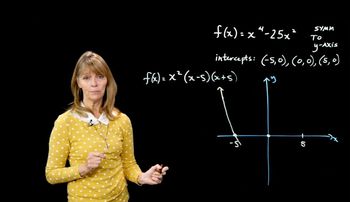Table of contents
- 0. Review of Algebra4h 16m
- 1. Equations & Inequalities3h 18m
- 2. Graphs of Equations43m
- 3. Functions2h 17m
- 4. Polynomial Functions1h 44m
- 5. Rational Functions1h 23m
- 6. Exponential & Logarithmic Functions2h 28m
- 7. Systems of Equations & Matrices4h 6m
- 8. Conic Sections2h 23m
- 9. Sequences, Series, & Induction1h 19m
- 10. Combinatorics & Probability1h 45m
4. Polynomial Functions
Dividing Polynomials
Problem 27
Textbook Question
In Exercises 17–32, divide using synthetic division. (x^5+x^3−2)/(x−1)
 Verified step by step guidance
Verified step by step guidance1
Identify the divisor and the dividend. Here, the divisor is \(x - 1\) and the dividend is \(x^5 + x^3 - 2\).
Set up the synthetic division. Write down the coefficients of the dividend: \([1, 0, 1, 0, 0, -2]\). Note the missing terms are filled with zeros.
Use the root of the divisor \(x - 1\), which is \(1\), as the number to use in synthetic division.
Bring down the leading coefficient \(1\) to the bottom row.
Multiply the root \(1\) by the number just written on the bottom row, and write the result under the next coefficient. Add this result to the next coefficient and write the sum below. Repeat this process for all coefficients.
Recommended similar problem, with video answer:
 Verified Solution
Verified SolutionThis video solution was recommended by our tutors as helpful for the problem above
Video duration:
5mPlay a video:
Was this helpful?
Key Concepts
Here are the essential concepts you must grasp in order to answer the question correctly.
Synthetic Division
Synthetic division is a simplified method for dividing polynomials, particularly useful when dividing by linear factors. It involves using the coefficients of the polynomial and a specific value (the root of the divisor) to perform the division in a more efficient manner than traditional long division. This technique streamlines calculations and is especially advantageous for higher-degree polynomials.
Recommended video:

Higher Powers of i
Polynomial Functions
A polynomial function is a mathematical expression involving a sum of powers in one or more variables multiplied by coefficients. In this context, the polynomial is represented as x^5 + x^3 - 2, which is a fifth-degree polynomial. Understanding the structure and behavior of polynomial functions is crucial for performing operations like division and analyzing their properties.
Recommended video:

Introduction to Polynomial Functions
Remainder Theorem
The Remainder Theorem states that when a polynomial f(x) is divided by a linear divisor of the form (x - c), the remainder of this division is equal to f(c). This theorem is useful in synthetic division as it allows for quick verification of the results and helps in understanding the relationship between the divisor and the polynomial's values at specific points.
Recommended video:

Higher Powers of i
Related Videos
Related Practice

